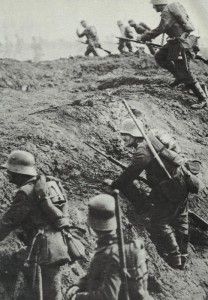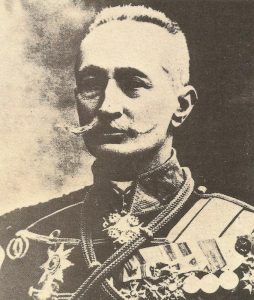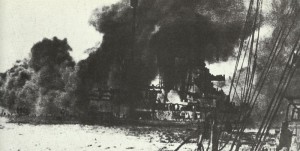The monthly days of 1916:
- January 1916
- February 1916
- March 1916
- April 1916
- May 1916
- June 1916
- July 1916
- August 1916
- September 1916
- October 1916
- November 1916
- December 1916
The situation at the fronts in 1916:
The war’s longest battle began on 21 February and lasted until December. The German preliminary bombardment was the heaviest yet seen in war. The most sanguinary fighting took place for possession of Forts Douaumont (February) and Vaux (June); at Hill 30; and on a hill called Le Mort Homme (‘Dead Man’s Hill’). Douaumont was levelled to the ground and the very earth around it reduced to the consistency of fine talcum powder. The defenders were led by General (later Marshal) Philippe Petain, under the watchwords Ils ne passeront pas ! (They shall not pass!). And they did not pass !
A round-the-clock, week-in week-out shuttle service of motortrucks kept the garrison constantly supplied. The prolongation and ferocity of the fighting soon bore little or no relation to the intrinsic importance of the German objective; 66 French and 42 German divisions were decimated. The German Chief of Staff, Falkenhayn, intended to ‘bleed the French Army white’. If the successful French counterattacks of August-September 1917 are included, casualties at Verdun totaled a round million (550,000 French, 450,000 German).
The Allied reply to the Verdun onslaught came in the Somme valley during July-November. But Haig’s unimaginative frontal attacks and the lamentable performance of the British artillery (despite adequate supplies of shells) brought no decisive result for the toll of 420,000 British and 195,000 French casualties during the Battle of the Somme. The battlefield debut of the tank (15 September) was on too small a scale to affect it. Disagreements over the Western Front stalemate and the fall of Romania helped bring down the Asquith Government; David Lloyd George was appointed Prime Minister by King George V in December 1916.
Between 4 June and 15 August 1916, the Austro-Germans suffered 700,000 casualties (including 360,000 PoWs); Russian losses stood at 550,000. In near-desperation, the Central Powers were forced to transfer no fewer than 44 divisions from all fronts to meet Brusilov’s deadly threat. But Romania’s entry into the war at the end of August, and the disasters which soon befell the cocksure Rumanians’ really brought Brusilov’s offensive to an end, by radically changing his mission, from the destruction of the Austro-Hungarian armies to the preservation of Romania, about a quarter of the Russian army had been drawn into the task of preventing a total Rumanian collapse. It was an ignominious end to an undertaking that had promised so well. By the end of the offensive, Brusilov’s armies had lost 1,412,000 men. Brusilov’s offensive was the last flourish of Imperial Russia.
The British force besieged at Kut in Mesopotamia, had to surrender to the Turks in April 1916 (the largest such capitulation since Kabul in 1842). But this was the Ottomans’ only success. Late in the previous winter (February 1916), the Russians under Yudenich had captured the strongly fortified city of Erzerum in Turkish Armenia. A second Turkish attack on the Suez Canal failed in August, while the Arab Sherif of Mecca proclaimed a revolt and received the assistance of a British mission, which included the extraordinary Captain T E Lawrence. Lawrence helped organize the Arab army and, during 1916-18, gave invaluable assistance to the British forces in Palestine by forming and securing their right flank.
In East Africa, a prolonged British and Belgian offensive directed by Smuts overran most of Germany’s last colony but at heavy cost from disease and without ever decisively defeating Lettow-Vorbeck’s resilient defenders.
The venerable Austrian emperor, Francis Joseph II, died on 21 November 1916, aged 86. He was succeeded by his grand-nephew, the Archduke Charles. Although not previously suspected of having any interest in or aptitude for anything beyond soldiering and devotion to his glamorous wife Zita and infant son, Charles was soon making earnest endeavors to save his gravely threatened inheritance and conclude peace. Renewing his efforts the following spring, he employed his brother-in-law, Prince Sixtus of Bourbon-Parma, to act as intermediary between the Austrian and French governments. However, neither this initiative nor a ‘peace note’ from Pope Benedict XV (August 1917) bore fruit. Other (less august) ‘peacemakers’ were the British peer, Lord Lansdowne, the German Baron von der Lancken and millionaire American industrialist Henry Ford.







